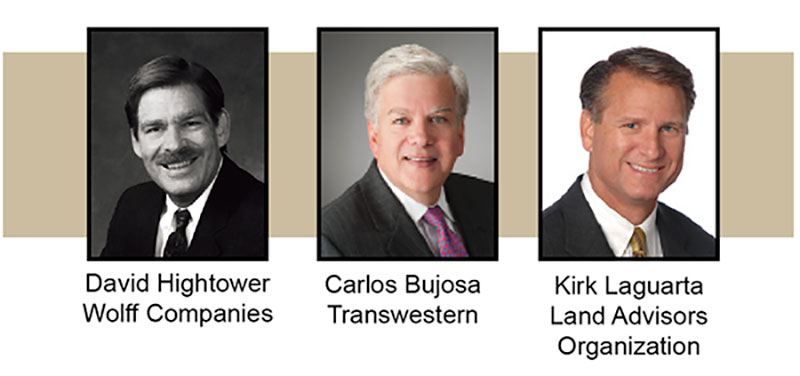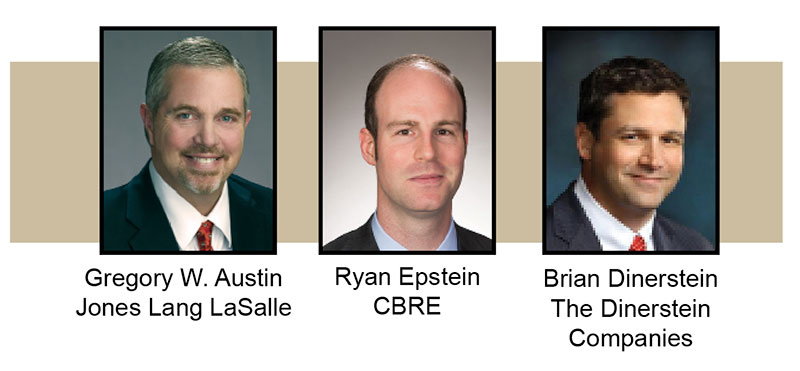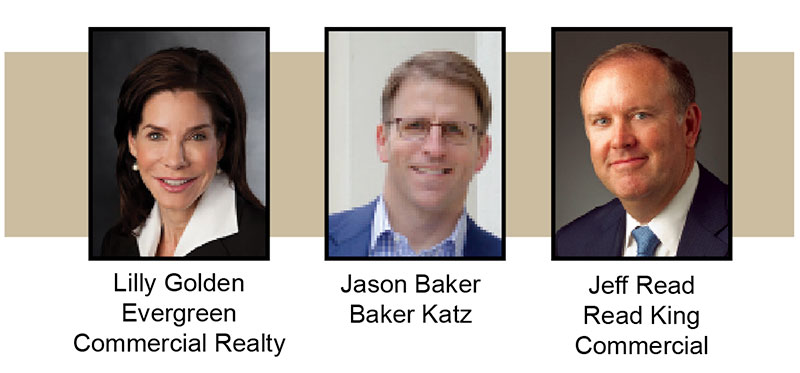Houston’s commercial real estate market will continue to be extremely active during 2015 amid a slight slowdown from 2014’s record-breaking year due to the recent oil slump.
That is the consensus of participants during the 2015 CCIM Forecast Competition on Feb. 13. The 22nd annual competition offers two perspectives on market trends by local real estate broker experts in the office, retail, industrial, land and multi-family markets. Sponsored by the CCIM Houston/Gulf Coast Chapter, a moderator for each land use kept the conversation flowing by asking specific questions of each participant at the event in the Westchase Marriott.
Dr. Mark Dotzour, Chief Economist at the Texas Real Estate Center at Texas A&M University, offered a positive outlook in the keynote address for both the area and the nation, saying he is still bullish on the economy based on historical trends. “We still have another three years of expansion,” Dotzour said.
He said low gasoline prices are enabling consumers to buy other products. “Cars are at their highest level of sales, and all lending classes, except mortgage lending, is up. U.S. households have money to spend.”
Land
Moderator: David Hightower, CCIM, Executive Vice President & Chief Development Officer, Wolff Companies
Contestants: Carlos Bujosa, Vice President, Transwestern and Kirk Laguarta, Land Advisors Organization
Bujosa started the discussion by saying he was seeing a lot of “uncertainty from buyers, but I’m still working a lot of deals with prices not being discounted. I have not seen the level of overall transactions drop yet.”
Land prices have dramatically increased in recent years , he said. An inner-city tract going for $80 per square foot in 2010 is now going for $150 to $200 per square foot, he said. “That type of pricing increase eliminated a lot of uses, both in the inner city and suburbs.”
Laguarta said the master-planned communities are still very active, and “builders are following each other.” Large transactions will be difficult because there is a lack of large tracts available, but also noted that pricing in The Woodlands, primarily because of ExxonMobil, is triple 2012 pricing.
Bujosa also said private developers are getting pushed aside by homebuilders because of the pricing challenge. It is not yet a seller’s market, he noted, because buyers are still making demands.
Areas to watch for development include the east end of downtown and the Baytown area, with the latter finally seeing some activity. Laguarta noted that any area with new roads will probably see expansion because such areas, like along the Grand Parkway, offer long-term value.
Both competitors agreed that land pricing increases along with rising construction costs make single-family development difficult. To keep housing affordable, developers and builders are having to build on smaller lots and in some cases, go vertical. The reputation of a school district also plays a large part in the viability of a new development.
Multi-family
Moderator: Gregory W. Austin, Partner, Berkadia Real Estate Advisors
Contestants: Ryan Epstein, Executive Vice President, CBRE and Brian Dinerstein, Partner, The Dinerstein Companies
Epstein said he hasn’t seen any big changes in the multi-family market, and referred to the current market as “reality vs. perception.” Traffic is still there, and tenants are not coming in saying they can’t pay their rent because they lost their jobs. On the other hand, he sees more opportunity for private investors while the institutional investors take a “pause.” Investments are still happening “in the right locations where the fundamentals are sound.”
Dinerstein agreed that traffic is still very good but cites some concern for the newer products and any projects under construction, although the pipeline will be slowing. Construction costs continue to increase while the biggest challenge is available labor. These factors account for projects taking longer to build in addition to still fighting some material shortages, he said.
They both agreed the multi-family market is doing quite well, with many people with good jobs opting to stay longer in apartments. Major reasons for this include traffic is not getting better so people are choosing to live near their work and many people are choosing to get married later in life. They also agreed empty-nesters are helping to fill some of the new projects.
Areas of the city with the greatest opportunity include the east end redevelopment, Clear Lake City and Pearland. Both predicted net absorption to range from 10,500 units to 13,000 units, with occupancy rates for Class A at 84% and for Class B, 92% to 95%.
Industrial
Moderator: David M. Boyd, CCIM, SIOR, Managing Principal, Boyd Commercial
Contestants: Thomas K. Lynch, SIOR, Senior Vice President, CBRE and John Ferruzzo, SIOR, Partner, NAI Partners
Houston’s industrial market is doing well, with occupancies as high as 95% for dock-high space, both contestants agree. They also predicted not much change in at least the first three quarters of 2015, with absorption ranging from 4.5 to 6 million square feet for the year.
Industrial is one sector that has been priced out of several markets due to the increasing land prices while other areas have seen a lot of spec developments being completed without leasing. Both Ferruzzo and Lynch agreed the rash of spec properties remaining available could bring the single-digit vacancy rates up but pointed out that the market will still be healthy. The industrial market has experienced low vacancy and positive absorption for most of the last 10 years.
Development will continue to occur on the northwest/west side (more so if land pricing falls), the east side and in Baytown, LaPorte and the ship channel area. They cited out-of-towners coming in and creating more diversity than in previous years, in addition to the petrochemical expansion on the east side fueling activity and “radically affecting” the market.
Retail
Moderator: Lilly Golden, CCIM, Principal & Founder, Evergreen Commercial Realty
Contestants: Jason Baker, CCIM, Principal, Baker Katz and Jeff Read, Principal and Managing Partner, Read King Commercial
The Houston retail market is booming with new grocery stores and multi-use developments, according to both Baker and Read. In retail, market share is the name of the game, and Walmart, Kroger and HEB each share 25% of the market for a total 75% market share. Each are opening new stores and trying out new concepts. Both retail experts noted the market will see some fallouts, perhaps from competitors like Fresh Market and Sprouts along with Randalls. When other big stores such as Whole Foods and Costco continue to expand and open new stores, there could be a huge shakeup, they said.
Both said retail continues to perform successfully as same store sales are higher this year than before; retail is always the last commercial segment to expand. The recent population growth has brought more consumers and more spendable income so the forecast looks good. The retail market has been stable the last few years and will remain so.
They pointed out areas of recent growth have been in the health industry’s opening of numerous emergency-type centers, which are on the upswing. All have been popping up in the “path of Mom’s shopping.”
Another significant change involves the Grand Parkway, which has created three larger centers overnight in the north corridor. This “largest loop in the world” is primarily responsible for the retail expansion there along with the “Exxon effect” and the demise of several “old, tired outlet centers.”
Both retail experts acknowledged the large population growth in the master-planned communities has created retail opportunities that have followed the rooftops. The predicted retail is just starting to respond to this unprecedented growth in eight of the top 20 communities, and land prices will slowly adjust.
Both Baker and Read forecast occupancy in 2015 to range between 93% and 95.2% with absorption from 4.95 million to 5.65 million square feet.
Office
Moderator: Brad Marnitz, NAI Partners
Contestants: Scott Martin, Executive Managing Director, Granite Partners and Steve Burkett, Executive Vice President, Jones Lang Lasalle
The two office contestants agree that 2014 was a great year for Houston’s office market, but provided vastly different views on the effect of the oil and gas energy slowdown in 2015. Martin, who operates on the landlord side, backed up his negative absorption forecast with basic math: he added up subleases already on the market due to oil and gas companies downsizing (such as the recent 250,000 square feet BP has placed on the market in its Westlake offices), added current availability, other space coming back on the market due to companies locating to newly built offices, and the approximate 5 million of uncommitted space in projects currently under construction.
Burkett, who works as a tenant broker, said there would be a slowdown but couldn’t agree that the office market would hit the low points reminiscent of the 1980s. He said the office market today is a lot different than that time in history, but said his job remains the same: to get the best possible deal for his client.
Both agreed the amount of sublease space to enter the market this year will be the key as to how the overall market weathers the effects of the oil pricing slump. Over 2 million square feet of sublease space has been placed on the market within the last 30 days.
This slowdown in leasing activity will give both tenants and landlords time to reflect before making a quick decision like many did last year. Both brokers acknowledge that landlords will have to work harder to make deals, perhaps offering incentives such as rental abatements, tenant improvements and other concessions. They also noted having an energy company leasing a lot of space in your building could be perceived as a huge risk in today’s market.
Expectations for 2015 depend on the clients’ business and where they want to be, Burkett said. Law firms are stabilizing and looking to expand while some companies are taking a short-term approach and signing one- or two-year expansions. Many tenants last year committed to 10- to 20-year deals.
As far as activity levels in different markets, both agreed on two value submarkets for the long term: the 290 and the Greenspoint areas. Until 290 construction is complete and the infrastructure is further along, most companies would not relocate there. With The Woodlands submarket taking over the north side of Houston, “dark clouds” have descended over the Greenspoint area. However, because of the high office vacancy, around 55%, that area offers an “incredible opportunity.”







